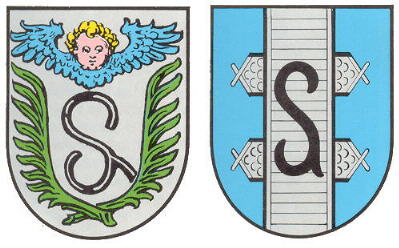Maximiliansau: Difference between revisions
Knorrepoes (talk | contribs) m (Text replacement - " / Arms" to "/Arms") |
Knorrepoes (talk | contribs) m (Text replacement - "{{media}} Literature : Stadler, 1964-1971, 8 volumes." to "Literature : Stadler, 1964-1971, 8 volumes. {{media}}") |
||
| Line 27: | Line 27: | ||
In the 19<sup>th</sup> century a pontoon-bridge was built for a railway connecting both banks of the Rhine. The bridge was an initiative of King Maximilian II of Pfalz-Bayern and the villages was renamed in 1938 after the King. The colours of the arms were also derived from the colours of the arms of [[Bayern]]. | In the 19<sup>th</sup> century a pontoon-bridge was built for a railway connecting both banks of the Rhine. The bridge was an initiative of King Maximilian II of Pfalz-Bayern and the villages was renamed in 1938 after the King. The colours of the arms were also derived from the colours of the arms of [[Bayern]]. | ||
[[Civic Heraldry Literature - Germany|Literature]] : Stadler, 1964-1971, 8 volumes. | |||
{{media}} | {{media}} | ||
[[Category:German Municipalities M]] | [[Category:German Municipalities M]] | ||
Revision as of 07:36, 8 September 2022
This page is part of the German heraldry portal |
Heraldry of the World |
|
German heraldry:
|
Selected collector's items from Germany:
|
MAXIMILIANSAU
State : Rheinland-Pfalz
District (Kreis) : Germersheim
Incorporated into : 1979 Wörth am Rhein
| German | |
| English | No blazon/translation known. Please click here to send your (heraldic !) blazon or translation |
Origin/meaning
The arms were granted in 1953.
The arms show the important railway bridge over the river Rhine, as well as the letter S derived from the old village seals.
In the 18th century the village, then named Pfortz, used a seal with the letter S and an angel and leaves (above left). The S is most likely the old village sign, whose origin is not known.
In the 19th century a pontoon-bridge was built for a railway connecting both banks of the Rhine. The bridge was an initiative of King Maximilian II of Pfalz-Bayern and the villages was renamed in 1938 after the King. The colours of the arms were also derived from the colours of the arms of Bayern.
Literature : Stadler, 1964-1971, 8 volumes.
Contact and Support
Partners:
Your logo here ?
Contact us
© since 1995, Heraldry of the World, Ralf Hartemink 
Index of the site












